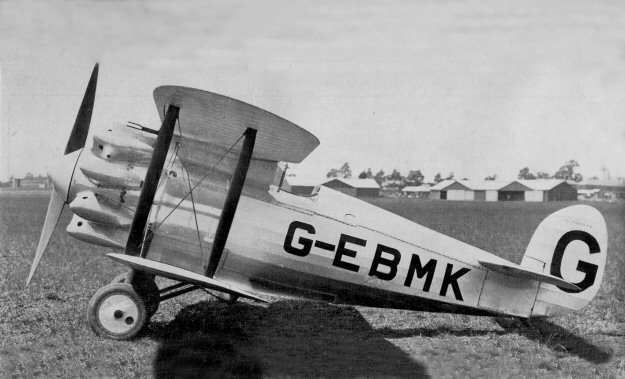
ASN Wikibase Occurrence # 56867
This information is added by users of ASN. Neither ASN nor the Flight Safety Foundation are responsible for the completeness or correctness of this information.
If you feel this information is incomplete or incorrect, you can submit corrected information.
| Date: | Thursday 28 July 1927 |
| Time: | |
| Type: | Bristol 99A Badminton |
| Owner/operator: | Bristol Aircraft Company |
| Registration: | G-EBMK |
| MSN: | 6921 |
| Fatalities: | Fatalities: 1 / Occupants: 1 |
| Aircraft damage: | Destroyed |
| Location: | Winterbourne, Wiltshire -
 United Kingdom United Kingdom
|
| Phase: | Manoeuvring (airshow, firefighting, ag.ops.) |
| Nature: | Test |
| Departure airport: | Filton Aerodrome, Filton, Bristol, Gloucestershire |
| Confidence Rating: |
First registered (C of R 1205) on 16/11/1925 to the Bristol Aeroplane Company Ltd., Filton, Bristol Gloucestershire.
Written off (destroyed) 28/7/1927 when crashed on a test flight and aircraft came down at Winterbourne, Wiltshire. The aircraft was being tested before the Kings Cup Air Race. The engine failed at about 200 feet, the pilot tried to glide the aircraft into land but lost too much speed and stalled. He was performance testing alternative propellers on the aircraft in preparation for entering the 1927 King's Cup Race. The engine failed after take-off from Filton Aerodrome, and the aircraft stalled from a height of about 80 feet. The pilot Captain Franklyn L Barnard O.B.E. and A.F.C was killed. He had served in the Air Force during WW1 and was a pilot with Instone Air Line and joined Imperial Airways as chief pilot on their conception. According to a contemporary report in "Flight" magazine (August 11, 1927 page 569 - see link #7)
"CAPT. F. L. BARNARD, O.B.E., A.F.C.
IT is with profound regret that we have to record the death, as the result of a flying accident on Thursday, July 28, of Capt. F. L. Barnard. Capt. Barnard—one of our most experienced and popular pilots—who was carrying out a test flight on the Bristol " Badminton " ("Jupiter VI ") biplane, which had been entered for the King's Cup Air Race, at Filton aerodrome, when, according to eyewitnesses, the engine suddenly stopped and the machine crashed to the ground just outside the aerodrome from a height of about 200 feet.
When a number of people who had been watching the flight arrived in the field where the machine had crashed, the latter was found completely wrecked, with the engine embedded in the ground, and the unfortunate pilot lying in the cockpit beyond human aid.
From evidence at the inquest, which was held on July 29, it appears that when Capt. Barnard's engine failed, he put the machine into normal gliding angle and attempted to land. While manoeuvring to do so, the machine lost flying speed and stalled from about 80 ft. Capt. Barnard had already made three other test flights on the machine, trying out different airscrews.
Capt. Barnard's loss to the aviation world is a great one indeed, for he was an exceptional pilot, careful, skilful, and daring—but daring only when flying alone or testing. He served in the Air Force during the war, and was awarded the Air Force Cross. Following the Armistice he was pilot to No. 24 Communication Squadron, when he carried many distinguished personages to and from the Continent. He then became associated with Instone Air Lines, and later, when Imperial Airways was formed, was their chief pilot.
His skill as a pilot was such that he was entrusted with many important aerial missions—the most conspicuous of which was the piloting of the Imperial Airways D.H. Hercules air liner, carrying Sir Samuel Hoare, Lady Maud Hoare and a party from London to Cairo on the inaugural flight of the Egypt-India service. He also, it will be remembered, took part in previous King's Cup races, being the winner in 1922 and 1925, and flying last year the Bristol Badminton in its original form.
Capt. Barnard leaves a widow and young son, to whom, in common with his many, many friends, we offer our deepest sympathy."
Sources:
1. Lewis, Peter. 1970. British Racing and Record-Breaking Aircraft. Putnam ISBN 0370000676
2. The National Archives file AIR 76/23/19
3. https://en.wikipedia.org/wiki/F._L._Barnard#Personal_life
4. https://www.flightglobal.com/pdfarchive/view/1927/1927%20-%200617.html
5. http://www.rcawsey.co.uk/Acc1929.htm
6. http://www.rafcommands.com/forum/showthread.php?17307-RAF-fatalities-1927
7. https://en.wikipedia.org/wiki/Bristol_Badminton
8. http://afleetingpeace.org/index.php/15-aeroplanes/82-register-gb-g-eb
9. https://cwsprduksumbraco.blob.core.windows.net/g-info/HistoricalLedger/G-EBMK.pdf
Images:

Media:


Revision history:
| Date/time | Contributor | Updates |
|---|---|---|
| 06-Jan-2009 05:01 | anorak48a | Added |
| 28-Dec-2017 07:26 | Sergey L. | Updated [Narrative] |
| 15-Jun-2018 20:44 | Dr. John Smith | Updated [Location, Departure airport, Source, Embed code, Narrative] |
| 15-Jun-2018 20:55 | Dr. John Smith | Updated [Source, Narrative] |
| 15-Jun-2018 20:56 | Dr. John Smith | Updated [Source] |
Corrections or additions? ... Edit this accident description
The Aviation Safety Network is an exclusive service provided by:


 ©2024 Flight Safety Foundation
©2024 Flight Safety Foundation